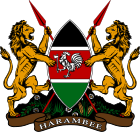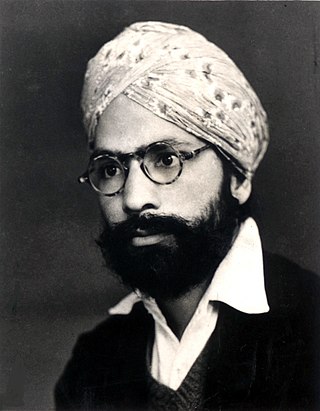 |
|---|
|
Economic schemes |
The Kenya Indian Congress (KIC) was a political party in Kenya founded by Alibhai Mulla Jeevanjee and Allidina Visram in Mombasa. [1] [2]
 |
|---|
The Kenya Indian Congress (KIC) was a political party in Kenya founded by Alibhai Mulla Jeevanjee and Allidina Visram in Mombasa. [1] [2]
The party was established at a meeting on 7 March 1914 as the East African Indian National Congress (EAINC), [3] and initially aimed to represent Indian interests across British East Africa, although it largely focused on Kenya. [4] It called for equality between Indians and Europeans, advocating the inclusion of Indians on the same roll as Europeans in elections and that Asians be allowed to farm in the White Highlands. [3]
The EAINC encouraged Indian immigration to Kenya, and became involved in humanitarian work in the 1930s, providing aid to victims of disaster in India and other countries in the region. [3] The party failed in an attempt to form an alliance with the Kenya African Union (KAU) in 1950, but the two combined to oppose plans by the Elector's Union to maintain European control of the colony. [3]
The organisation was renamed the Kenya Indian Congress (KIC) in 1952 after Indians in Tanganyika formed the Asian Association. [4] In 1960 the Kenya Freedom Party (KFP) was formed by a group of Indians who believed that the KIC was not sufficiently supportive of independence. [5] General elections the following year saw the KIC win three of the 53 elected seats in the Legislative Council with 1.2% of the vote, whilst the KFP won two seats.
At its annual meeting in 1962 the KIC opted to dissolve itself as a political party as it was "no longer desirable to function politically as an Asian organisation." [6]

A part of Eastern Africa, the territory of what is known as Kenya has seen human habitation since the beginning of the Lower Paleolithic. The Bantu expansion from a West African centre of dispersal reached the area by the 1st millennium AD. With the borders of the modern state at the crossroads of the Bantu, Nilo-Saharan and Afro-Asiatic ethno-linguistic areas of Africa, Kenya is a multi-ethnic state. The Wanga Kingdom was formally established in the late 17th century. The Kingdom covered from the Jinja in Uganda to Naivasha in the East of Kenya. This is the first time the Wanga people and Luhya tribe were united and led by a centralized leader, a king, known as the Nabongo.

Makhan SinghJabbal was a Kenyan labour union leader who is credited with establishing the foundations of trade unionism in Kenya. He is credited to have played a vital role in the Kenyan Freedom Struggle. He was detained by the British colonialists for 11 years from 1950 to 1961 - the longest ever political detention in Kenya's history.
Pio Gama Pinto was a Kenyan journalist, politician and freedom fighter. He was a socialist leader who was key in Kenya's struggle for independence. He was assassinated in 1965, leading many to consider him independent Kenya's first political martyr.

Indians in Kenya, often known as Kenyan Asians, are citizens and residents of Kenya with ancestral roots in the Indian subcontinent. Significant Indian migration to modern-day Kenya began following the creation of the British East Africa Protectorate in 1895, which had strong infrastructure links with Bombay in British India. Indians in Kenya predominantly live in the major urban areas of Nairobi and Mombasa, with a minority living in rural areas.

General elections were held in Kenya in February 1961. The result was a victory for the Kenya African National Union, which won 19 of the 53 elected seats.

Alibhai Mulla Jeevanjee was an Indian-born Kenyan merchant, politician and philanthropist. He was amongst the first and most influential Indian settlers in Kenya, amassing significant wealth and becoming a leader of Kenya's Indian community.

The New Kenya Party was a political party in Kenya.
Sir Michael Blundell was a Kenyan farmer and politician who served as a member of the Legislative Council from 1948 until 1963, and as Minister of Agriculture in two spells between 1955 and 1962.

The Kenya Coalition was a political party in Kenya.

The United Country Party was a political party in Kenya.

The Kenya Freedom Party (KFP) was a political party in Kenya.

The African People's Party (APP) was a political party in Kenya.

The Kenya Social Congress (KSC) is a political party in Kenya. Its symbol is a broom. The party is currently led by Samson Atati Kengere, with Dennis Anyoka as deputy leader.

The Kenya National Democratic Alliance (KENDA) is a political party in Kenya.

The United Party was a political party in Kenya.

The Kenya National Party (KNP) was a political party in Kenya.

The Legislative Council of Kenya (LegCo) was the legislature of Kenya between 1907 and 1963. It was modelled on the Westminster system. It began as a nominated, exclusively European institution and evolved into an elected legislature with universal suffrage. It was succeeded by the National Assembly in 1963.
The Devonshire White Paper or Devonshire Declaration was a document written in 1923 by the colonial secretary Victor Cavendish, 9th Duke of Devonshire, regarding the status of settlers and natives in the Kenya Colony, and East Africa more broadly. The paper stated that whenever the interests of the native Africans clashed with those of Asian, European, or Arab settlers, those of the Africans should prevail. The Declaration blocked the move towards self-government advocated by the colonialists, and in its place advocated a policy of trusteeship, whereby the imperial state would protect the interests of Africans. Although the Paper had little effect on the welfare of native Africans, it nonetheless set a precedent for future conflict resolution between the various groups living in the colony.
Isher Dass was an Indian born member of the Legislative Council of Kenya between 1933 and his death in 1942. He was the first member of the Legislative Council to be assassinated.
Mohamed Ismail Shams-ud-Deen was an Indian born member of the Legislative Council of Kenya between 1922 and 1946.